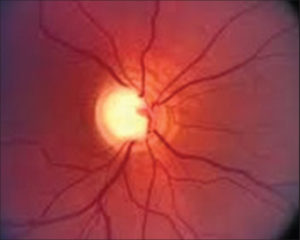This month’s guest blog post was written by Jessica Schiffbauer, OD. She is residency trained in ocular disease management and comprehensive post-operative care.
 January is glaucoma awareness month. Glaucoma is the second leading cause of worldwide blindness. Glaucoma is an ocular condition involving cupping of the optic nerve due to the loss of retinal ganglion cells. It can eventually affect a person’s peripheral vision and lead to blindness. Typically, glaucoma patients are asymptomatic until the more advanced stages.
January is glaucoma awareness month. Glaucoma is the second leading cause of worldwide blindness. Glaucoma is an ocular condition involving cupping of the optic nerve due to the loss of retinal ganglion cells. It can eventually affect a person’s peripheral vision and lead to blindness. Typically, glaucoma patients are asymptomatic until the more advanced stages.
There are approximately 3 million Americans who are living with glaucoma. Unfortunately, only about 50% of Americans know that they have glaucoma.
There are many risk factors for the development of glaucoma. The most common risk factor is elevated intraocular pressure, however many may still present with normal intraocular pressure. Other risk factors include African American, family history, high myopia, narrow angles, history of trauma, and certain systemic conditions such as diabetes and hypertension.
There are many diagnostic tests that are used to determine whether a patient has glaucoma. In order to make the diagnosis of glaucoma, one must measure the intraocular pressure and also, examine the anterior chamber angle with a gonioscopy. Physicians are also examining the optic nerve and looking for characteristic signs of damage such as a large cup to disc ratio, asymmetry between the two eyes, vertical elongation of the cup, rim thinning or notching, or disc hemorrhage. Visual fields are the gold standard of diagnosis of glaucoma and will highlight any areas of peripheral vision loss. All of these tests are repeated across a series of follow-up visits.
 There is no cure for glaucoma and vision loss is irreversible, but many treatments are available to hopefully help slow the progression. The main goal of all these treatments is to lower the intraocular pressure. Many patients are treated with eye drops that are prescribed one to three times per day. Laser procedures are another treatment option. Additionally, there are surgical procedures that can help lower the pressure of the eye. We are fortunate to have many surgeons including two glaucoma specialists on board that offer an array of these procedures. These procedures can include minimally invasive glaucoma surgeries such as ABiC, Trabectome, or iStent or glaucoma drainage implants such as Ahmed Valve or Baerveldt.
There is no cure for glaucoma and vision loss is irreversible, but many treatments are available to hopefully help slow the progression. The main goal of all these treatments is to lower the intraocular pressure. Many patients are treated with eye drops that are prescribed one to three times per day. Laser procedures are another treatment option. Additionally, there are surgical procedures that can help lower the pressure of the eye. We are fortunate to have many surgeons including two glaucoma specialists on board that offer an array of these procedures. These procedures can include minimally invasive glaucoma surgeries such as ABiC, Trabectome, or iStent or glaucoma drainage implants such as Ahmed Valve or Baerveldt.
It is important to have a comprehensive eye exam annually to monitor or screen for any glaucomatous manifestations.
~ Dr. Jessica Schiffbauer, Virginia Eye Consultants
